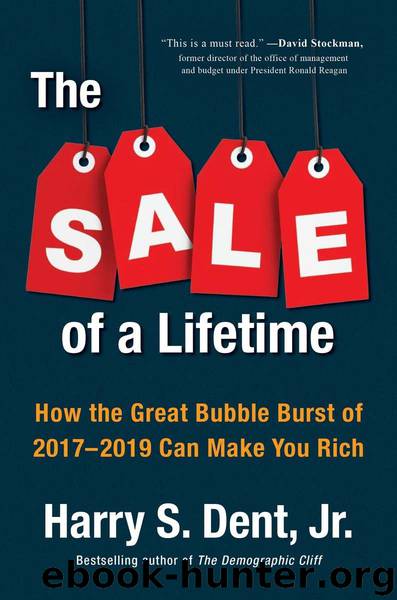The Sale of a Lifetime: How the Great Bubble Burst of 2017-2019 Can Make You Rich by Dent Harry S

Author:Dent, Harry S. [Dent, Harry S.]
Language: eng
Format: epub
Publisher: Penguin Publishing Group
Published: 2017-01-02T16:00:00+00:00
PART IV
The Greatest Bubble and Reset of Our Lifetime
CHAPTER 14
The Single Greatest Economic Force the World Has Ever Seen
I’LL GO INTO every detail of the greatest debt and financial bubble of our lifetime—and the fire-sale opportunities it will hand us—soon. But before I do, there’s another important bubble that we must consider. Ultimately, it has played the instrumental role in leading us to the point where we now find ourselves. Of course, I’m talking about the baby boomers.
They have proved, without a shadow of a doubt, that consumers drive economies and markets, not “sentiment” or the government, not interest rates . . . inflation . . . or the price of oil, not the Fed or the president, not the weather or even wars, past a point. Sure, all those things have an impact, but the most powerful force in the economy is people, and this became obvious to me from the larger-than-normal impact of the baby boomers—that “pig moving through a python.”
They have proved to be a group so powerful they have affected everything that Americans (and the world) eat, drink, and do today. They quite literally changed the world. And they will continue to do so for a few more decades.
I explained earlier that I refer to the baby boomers as the largest generation. While there are numerically more millennials and echo boomers, the former are far more impactful because of their much more rapid increase over a shorter timeframe. Like I’ve said, they’re a pig moving through a python.
It would be useful at this point to also explain how I calculate the size of the generation. It’s not the more commonly practiced method.
You see, most people will tell you that the baby boomers were born between the years 1946 and 1964, adding 76 million people to the population. That’s the generally accepted view, but it misses the true enormity and influence of this generation.
A marketer coined the term “baby boomer”—which first appeared in The Washington Post in 1970. He was creating a social classification that referred to how those born after World War II viewed the world. Between 1946 and 1964, the general environment was one of growth and prosperity.
The problem with that classification is, of course, that it’s highly subjective and nebulous. It was based on higher-than-average birthrates by sociologists—who, like economists, rarely have sex or run a business.
I measure the baby boomers differently . . . more accurately . . . scientifically, if you will . . . so that I can harness the predictive power of this cohort. I’m interested in the rising and falling wave of births.
Rather than considering the social environment, I want to look simply at the numbers: when was the lowest number of births on the National Birth Index . . . and when was the highest?
And as the numbers show, in reality, the generation began in 1934 (after the bottom in births in 1933) and peaked in 1961, as you can see:
Download
This site does not store any files on its server. We only index and link to content provided by other sites. Please contact the content providers to delete copyright contents if any and email us, we'll remove relevant links or contents immediately.
International Integration of the Brazilian Economy by Elias C. Grivoyannis(74657)
The Radium Girls by Kate Moore(11619)
Turbulence by E. J. Noyes(7700)
Nudge - Improving Decisions about Health, Wealth, and Happiness by Thaler Sunstein(7242)
The Black Swan by Nassim Nicholas Taleb(6762)
Rich Dad Poor Dad by Robert T. Kiyosaki(6174)
Pioneering Portfolio Management by David F. Swensen(6078)
Man-made Catastrophes and Risk Information Concealment by Dmitry Chernov & Didier Sornette(5646)
Zero to One by Peter Thiel(5488)
Secrecy World by Jake Bernstein(4388)
Millionaire: The Philanderer, Gambler, and Duelist Who Invented Modern Finance by Janet Gleeson(4093)
The Age of Surveillance Capitalism by Shoshana Zuboff(3983)
Skin in the Game by Nassim Nicholas Taleb(3965)
The Money Culture by Michael Lewis(3846)
Bullshit Jobs by David Graeber(3828)
Skin in the Game: Hidden Asymmetries in Daily Life by Nassim Nicholas Taleb(3720)
The Dhandho Investor by Mohnish Pabrai(3560)
The Wisdom of Finance by Mihir Desai(3523)
Blockchain Basics by Daniel Drescher(3329)
